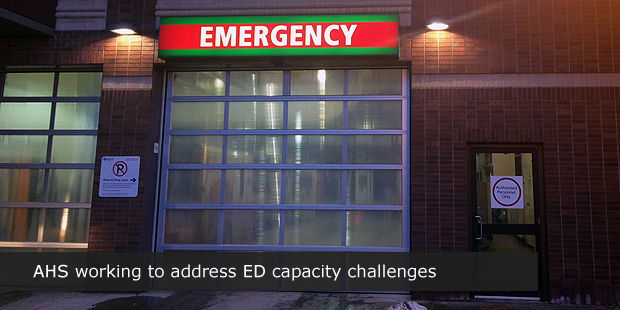
The very nature of an emergency department means that it can be a stressful, difficult and challenging place to be - for both our patients, family members, and our frontline staff.
Emergency departments are particularly challenged when we experience spikes in patient visits. Waiting rooms are filled, staff and physicians are extremely busy, and frustration levels are high.
Albertans should be reassured, however, that if they need emergency care, they will receive it. We are very aware of the challenges capacity issues present at our emergency departments, and we are constantly working to address those challenges in an effort to improve both access, and care.
Traditionally, this is a particularly busy time of year. Cold weather leads to more people needing help with respiratory issues, and we see an influx of influenza-related cases and other weather-related injuries.
We see more people with broken hips, ankles and wrists, having slipped and fallen on ice. We see more people with colds, pneumonia and more serious, influenza-type illnesses. And we see higher numbers of patients with more problematic health issues.
This is certainly the case right now.
We understand that our staff and physicians are frustrated by emergency department wait-times. We have, and will, continue to meet with them to discuss their concerns, and we will continue to work together on solutions.
The average daily number of patients presenting at the University of Alberta Hospital emergency department over the course of a month has not changed significantly in the past 23 months.
In January 2013, an average of 179 people visited the UAH ED each day. Last month the daily average was 176, while this month the daily average sits at 172.
That said, we do see fluctuations in capacity and we have certainly seen that this week. We know that there are times when an emergency department – and staff and physicians – are under significant pressure.
We have also seen an increase in the number of patients who need to be moved to a more appropriate continuing care space, but are waiting in hospital for such a space to become available.
There is no quick fix, no one answer that would immediately solve capacity challenges in our emergency departments. However, we do have several initiatives in place to try to alleviate capacity issues when they occur.
These include two Rapid Transfer Units that we are piloting in the Edmonton Zone – at the University of Alberta Hospital, and Royal Alexandra Hospital.
These units are part of a five-month pilot project aimed at moving patients out of the ED, and into beds where they can be looked after until either they can be discharged home with home care if required or are moved into a more appropriate acute care or continuing care bed.
These new Rapid Transfer Units have already had a positive impact on patient flow. For example, as of Monday, December 8, the University of Alberta Hospital unit had seen 106 patients in that time - that is 106 patients who did not have to wait in the ED to be treated, and that is 106 ED spaces that were freed up for other ED patients.
At the Royal Alexandra Hospital, the Rapid Transfer Unit has reduced the number of patients in over capacity spaces significantly - from an average of 12 to 15 a day, to two to four a day.
This is not just an emergency department issue, and we are taking steps to improve patient flow, which in turn reduces capacity pressures on our emergency departments.
For example, we have opened 77 continuing care beds in the Edmonton Zone in the past month, which have allowed us to move patients out of acute care beds. That, in turn, frees up acute care spaces, which reduces ED capacity. 140 more continuing care beds will open across the province by December.
At the University of Alberta Hospital, the ED Chief of Staff has also encouraged physicians to assist nursing staff by assessing patients in the waiting room, if appropriate. This is not new, and is another tool that can help us ensure patients get timely, appropriate care.
Physicians working in waiting rooms can help expedite diagnosis by ordering lab work and diagnostics such as ultrasounds and ECGs that can then shorten a patient's waiting time in the department.
Those assessments will only take place if physicians are comfortable doing them.
We certainly acknowledge that there are hospitals experiencing capacity pressures, and we are grateful for the amazing work that happens daily thanks to our hard-working and dedicated staff and physicians.
Add your comment